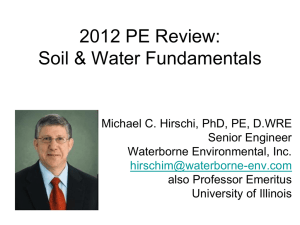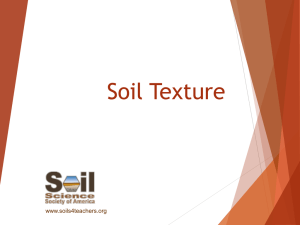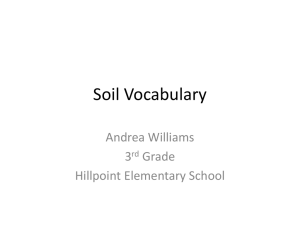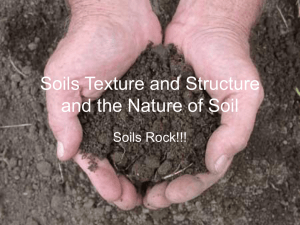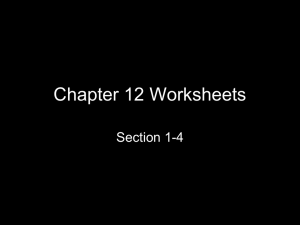PPT Slides
advertisement
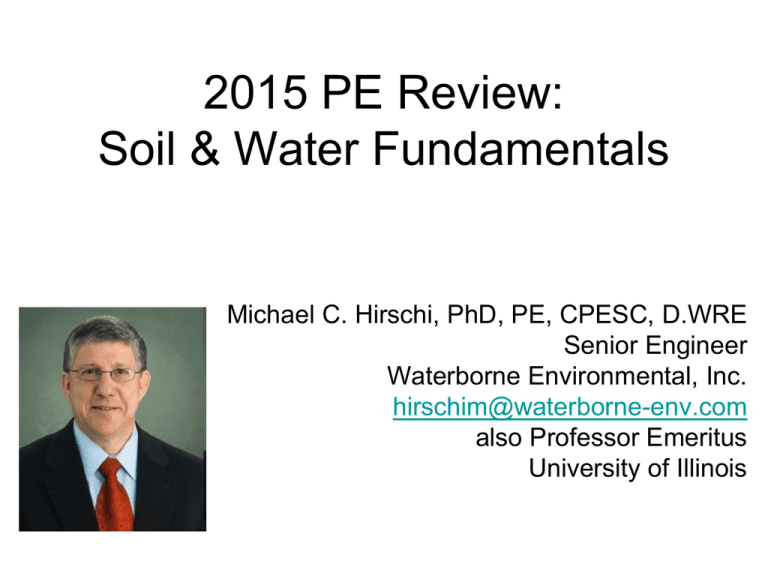
2015 PE Review: Soil & Water Fundamentals Michael C. Hirschi, PhD, PE, CPESC, D.WRE Senior Engineer Waterborne Environmental, Inc. hirschim@waterborne-env.com also Professor Emeritus University of Illinois Acknowledgements: Rod Huffman, past PE Review coordinator Daniel Yoder (2006 presenter of parts) Rabi Mohtar & Majdi Abu Najm (2010 presenters of parts) Topics • • • • Core principles – Fluids Soil-Water Basics Soil Erosion Principles Water Quality Principles Sources • Environmental Soil Physics; Hillel; 1998 Hi • Soil and Water Conservation Engineering – 4th ed. Schwab, Fangmeier, Elliott, Frevert: S4 – 5th ed. Fangmeier, Elliott, Workman, Huffman, Schwab: S5 – 6th ed. Huffman, Fangmeier, Elliott, Workman & Schwab: S6 • Design Hydrology & Sedimentology for Small Catchments; Haan, Barfield, Hayes: H Fluids Review - Assumptions • Water in its liquid state – Low dissolved contaminants – Low suspended contaminants • Such that ρ (density) = 1.0 kg/L • Incompressible • Mass is conserved Basic nomenclature • Density is denoted as ρ, with units of mass/volume (kg/L, g/mL, slugs/ft3, etc.) • Flow rate is usually denoted as Q, with units of volume/time (cfs or ft3/sec, cms or m3/sec, gallons/min, L/min, etc.) • Velocity is denoted as V, with units of length/time (ft/sec, m/sec, etc.) • Area of flow is denoted as A, with units of length2 (ft2, m2, etc.) Flow rate The basic relationship between flow rate and velocity is then: Q=V*A which is a statement of conservation of mass. In addition, energy is neither created or destroyed, so an energy balance relationship also holds… The energy balance equation is Bernoulli’s equation: h1 P1 γ 2 v1 2g W F h2 P2 γ 2 v2 2g h = elevation of point 1 or 2 (m or ft) P1 = pressure (Pa or psi) at point 1 γ = specific weight of fluid v = velocity of fluid (at 1 or 2, according to subscript) W is energy added by a device (such as a pump) F is energy used to overcome friction Considering energy: Energy input from device h1 P1 γ Energy output to heat (friction) v 2 1 2g W F h2 P2 γ v 2 2 2g Energy stored as Pressure Potential Energy Kinetic Energy Example use of energy balance… • Need to size pump for irrigating gardens at lot 90 feet above Smith Mountain Lake in Virginia… • Location 1 is the lake, location 2 is a tank near the garden. – So, h1 = 0; h2 = 90ft; v1 = 0, v2 depends upon flow rate; P1 = 0; P2 is also 0 because the pipe exits to the atmosphere above the tank; F depends upon size of pipe and fittings (that’s another webinar), assume F = 20 feet. • The owner wants his 500 gallon tank to fill in 2 hours through the 0.75 inch pipe he installed. How much energy must the pump add? Rearranging, to solve for W… W = h2-h1 + 1/γ*(P2-P1)+ 1/2g*(v22-v12)+F P2 = P1, Q=500gal/120min/60s/min/7.48gal/ft3 = 0.0093cfs; A= (0.75)2*3.14/4/144 = 0.003 ft2, so v2 = 3.1fps W=90-0 + 1/γ*(0-0)+1/2/32.2*(3.1)2 + 20 So W = 90+0.15+20 = 110 feet of head Pump specification • So, when the owner goes shopping, he needs to look for a pump that will deliver at least 4.2 gpm (500 gallons in 120 minutes) against 110 feet of water head. Translating head to pressure, there are 2.31 feet of head per psi, so the pump needs to generate 48psi at the pump housing while delivering 4.2 gpm. So, a pump that delivers 5gpm at 50psi would be fine. Questions on fluids basics? Soil-water basics • Soil classes and particle size distributions • Soil water – Content – Potential – Flow Basics – Soil Make Up • • • • Mineral Water Air Organic Matter Mineral Component - Particles • • • • Sand Silt Clay Aggregates – Silt & Sand sizes – Less dense than primary particles Particle Size Classifications USDA Texture Triangle Example After soil sample dispersal to ensure only primary particles are measured, a sample is determined to be 20% clay, 30% silt and 50% sand. What is the USDA soil texture? A: Sandy Clay Loam B: Sandy Loam C: Loam D: Clay Loam Solution Answer: C, Loam 30% Silt 20% Clay Infiltration & soil-water • Infiltration is the passage of water through the soilair interface into pores within the soil matrix • Movement once infiltrated can be capillary flow or macropore flow. The latter is a direct connection from the soil surface to lower portions of the soil profile because of root holes, worm burrows, or other continuous opening • Infiltrated water can reappear as surface runoff via “interflow” and subsurface drainage Soil, water, air The inter-particle space (voids) is filled with either water or air. The amount of voids depends upon the soil texture and the condition (ie. tilled, compacted, etc.). Water (moisture) content • Special terms reflect the fraction of voids filled with water (all vary by texture and condition): – Saturation: All voids are filled with water – Field Saturation: Natural “saturated” moisture content which is lower than full saturation due to air that is trapped. – Field capacity: Water that can leave pores by gravity has done so (0.1 to 0.33 bars) – Wilting point: Water that is extractable by plant roots is gone (15 bars) – Hygroscopic point: Water that can be removed by all usual means is gone (but some remains, 30 bars) Saturated (all pores filled) Field Capacity (Some air, some water) Wilting point (water too tightly held for plant use) Plant Available Water Soil Water Holding Capacity (inches-water/foot-soil) Soil Texture Sand Sandy Loam Loam Silt Loam Clay Loam Clay Range 0.4 - 1.0 1.0 - 1.5 1.0 - 2.0 1.3 – 2.6 1.3 – 2.6 1.4 – 2.4 Average 0.8 1.3 1.6 2.0 2.0 1.8 Water States by Soil Texture Volumetric Water content 60 50 40 Gravitational 30 Plant Available 20 Unavailable 10 0 Sand Sandy Loam Loam Silt Loam Clay Loam Clay Commentary • In a later webinar, when we discuss drainage, it is the gravitational water that is of interest, eg. saturation down to field capacity. The volume of this water, the hydraulic characteristics of the soil in question, and the wet-conditiontolerance and value of the crop being grown dictate the drainage system design and its feasibility. • When we consider irrigation, plant available water (AW) is that held between field capacity and wilting point. It is this water that we manage via irrigation to supply water to plants. The volume of AW the soil can hold within the crop root-zone, the crop value and water use, and the crop tolerance of dry conditions dictate irrigation design and feasibility. Moisture “release” curve -10000cm -1000cm -100cm -10cm Any questions on general soil and water basics? Soil Erosion Principles • Soil erosion is a multi-step process: – Soil particle/aggregate detachment – Soil particle/aggregate transport – Soil particle/aggregate deposition • There must be detachment and transport for erosion to occur • Deposition (sedimentation) will occur somewhere downstream A little soils refresher… • Soil primary particles: – Sand, 0.05mm to 2mm, 2.65 g/cc density – Silt, 0.002mm to 0.05mm, 2.65 g/cc – Clay, <0.002mm, 2.6 g/cc • Soil aggregates, chemically/electrically bonded sets of primary particles: – Large, in the sand range, 1.6 g/cc – Small, in the large silt range, 1.8 g/cc • These aggregate sizes are approximately those used in the CREAMS model (USDA-ARS) Detachment • There are many sources of force and energy required to detach soil particles & aggregates: – Raindrop impact – Shallow surface flow shear – Concentrated flow shear – Many more, at larger scales Transportation • Many of the same processes contribute force and energy for soil particle & aggregate transport: – Raindrop impact – Shallow surface flow – Concentrated surface flow – Channelized flow – Others Balancing act • Foster & Meyer (1972) proposed a balance between detachment and transport for flowing water: • 1 = (transport load/transport capacity) + (detachment load/detachment capacity) Essentially, if the flow is using all its transport capacity transporting sediment, there’s nothing left to detach more. Likewise, if the flow is detaching new sediment at detachment capacity, there’s no capacity to transport any sediment. Natural systems balance out… Example • In the 80’s and 90’s there was a successful push to conservation tillage as a method to reduce sediment in lakes and streams • In many situations, no improvement was seen, but streambank erosion became more of a problem than it was in the past • I contend that now that the streams are receiving cleaner water (because of less upland erosion), but at similar rates, from farm fields, the stream uses less of its erosive energy to transport load it receives from runoff water, so it has capacity to undercut banks and scour the streambed Multi-stage erosion Sediment transport • Settling (H.204-209) – Stokes’ Law • • • • • 2 1 d g SG 1 Vs 18 Vs = settling velocity d = particle diameter g = accel due to gravity SG = particle specific gravity ν = kinematic viscosity – Simplified Stokes’ Law • SG = 2.65 • Quiescent water at 68oF • d in mm, Vs in fps V s 2 . 81 d 2 Example: Settling Velocities • Given: – ISSS soil particle size classification • Find: – Settling velocities of largest sand, silt, and clay particles • ISSS classification – Largest particles size • Clay = 0.002mm • Silt = 0.02mm • Sand = 2.0 mm – Vs,clay = 1.12*10-5 fps = 0.04 ft/hr = 0.97 ft/day – Vs,silt = 0.0011 fps = 4.05 ft/hr = 97 ft/day – Vs,sand = 11.24 fps = 7.66 mph = 970,000 ft/day Another example… • Given: – Stokes’ Law settling • Find: particles larger than what size can be assumed to settle 1 ft in one hour? • Vs = [(1 ft)/(1 hr)](1 hr/3600s) = 2.778*10-4 fps • d = (Vs/2.81)1/2 = 0.00994mm (in the silt range) Application of process knowledge to control • Limit individual parts to limit whole – Limit detachment – Limit transport • Enhance deposition strategically – Where damage is minimal – Where cleanup is possible Control of Soil Erosion by Water • Detachment limiting strategies – Reduce raindrop impact – Reduce runoff – Reduce detachment capacity of runoff – Increase soil resistance to erosive forces • Transport limiting strategies – Reduce runoff volume – Reduce runoff transport capacity Example – No-Till • Detachment – Raindrop impact detachment is very low due to high surface cover percentage – Flow shear detachment is low due to low velocities caused by tortuous flow path – Soil is resistant to erosion because of low disturbance • Transport – Raindrop transport is limited by surface residue – Flow transport is limited by increased infiltration, lessening runoff – Flow transport is further limited by small dams created by surface residue Example – Mulch on newly seeded area • Detachment – Raindrop impact detachment is very low due to high surface cover percentage – Flow shear detachment is low due to low velocities caused by tortuous flow path • Transport – Raindrop transport is limited by surface residue – Flow transport is limited by increased infiltration, lessening runoff – Flow transport is further limited by small dams created by surface residue Comparison of no-till vs. mulch • Detachment – Likely higher with mulch for same surface cover fraction because of higher soil disturbance for seedbed preparation – Likely higher for no-till following dry years because amount of residue cover is dictated by prior year crop growth • Transport – Likely higher for mulch, unless “cut” in because no-till residue is effectively “cut” in during planting, at least for a small area, hopefully across slope – Likely higher for mulch situation because seedbed prep likely reduced average aggregate diameter Control of Sediment in Runoff • Reduce transport capacity of flow • Enhance deposition of sediment Reduce transport capacity • Reduce velocity – Barriers • Must let water pass, though slowly • Must be flow-stable, even after use • Must be where maintenance is possible – Reduce slope steepness • Channel must be of adequate capacity • Increase infiltration Enhance deposition of sediment • Use flocculant to increase sedimentation – Usually in sedimentation ponds when other methods are not adequate – Expensive… Questions on erosion principles? Water Quality Principles • Concentration • Load Concentration • Concentration can be defined different ways: – Mass of contaminant per mass of material – Mass of contaminant per volume of material • Units might be ppt, ppm, ppb, mg/L, µg/L, ng/L Concentration in water Consider the following concentrations of a herbicide in well water: 1000 1 0.001 Which would you prefer to find in your well? Yes, it is a trick question… Adding units: 1000 ug/L (ppb) 1 mg/L (ppm) 0.001 g/L (pp(th)) how about another: 1,000,000 ng/L (pp(tr)) Water only! • Please remember that ppm = mg/L ONLY for liquids with a density of 1.0 mg/L (water) Load versus concentration • As we have seen, concentration is the mass of a contaminant in a given volume of water • Load is the rate of contaminant mass movement, equal to the concentration times the flow rate, C (mass/volume) * Q (volume/time) Regulations • Maximum Contaminant Level (MCL) is a concentration above which public drinking water systems must treat the water. • Total Maximum Daily Load (TMDL) is a contaminant load in kg/day or some other unit. Questions? Thank you!
